Content
- Clear the myths, recognise organ donation as a lifeline
- Dogs and laws
Clear the myths, recognise organ donation as a lifeline
Context and Importance
- Organ transplantation: One of modern medicine’s greatest achievements; gold standard for terminal and irreversible organ failure.
- Current gap in India:
- 500,000 lives lost annually due to lack of suitable donor organs.
- Transplants performed: 4,990 in 2013 → 18,378 in 2023.
- Deceased donors: only 1,099 after brain death.
- Organ donation rate: 0.8 per million population vs >45 per million in Spain/USA.
- 500,000 lives lost annually due to lack of suitable donor organs.
- Significance: Each preventable death represents a social, ethical, and medical challenge; organ donation is a life-saving intervention.
Relevance : GS 2(Health , Social Issues)
Practice Question : India’s low organ donation rates are rooted more in myths, misinformation, and social barriers than in medical or technical limitations. Discuss the factors inhibiting organ donation and suggest policy, awareness, and system-level reforms to bridge the gap between demand and supply. (250 words, 15 marks)

Barriers to Organ Donation
Myths and Misconceptions
- Disfigurement of body
- Families fear organ retrieval affects funeral rites.
- Reality: Procedures preserve appearance; medical teams respect cultural practices.
- Religious concerns
- Misbelief: organ donation violates spiritual norms.
- Reality: Faith leaders endorse donation as a compassionate act compatible with all religions.
- Premature brain death fears
- Some fear hospitals declare death early for organ harvesting.
- Reality: Brain death determined under Transplantation of Human Organs and Tissues Act, 1994:
- Strict clinical and legal framework.
- Multidisciplinary board confirmation.
- Repeated assessments and documentation.
Age and Health Misconceptions
- Myth: Only young accident victims are eligible.
- Reality:
- Older donors and natural deaths can contribute.
- Organs/tissues like kidneys, liver segments, lungs, corneas, bone, skin, heart valves save or improve lives.
Awareness and Education Strategies
- Mass media campaigns
- Audio-visual content on TV and social media targeting younger audiences.
- Human storytelling
- Real donor families and transplant recipients communicate impact.
- Community workshops
- Led by trained counsellors; safe space for questions about rites, protocols, and eligibility.
- Educational integration
- Curriculum inclusion in life sciences and ethics in schools/colleges.
- Peer-to-peer education empowers students to spread awareness.
- Health-care professional engagement
- Training for physicians, nurses, and staff to initiate compassionate discussions.
- Dedicated transplant coordination teams guide families through decision-making.
Policy and System-Level Considerations
- National will and governance: Bridging demand-supply gap requires sustained political, administrative, and social commitment.
- Presumed consent model
- Successful in Spain, Croatia.
- Default donation unless adult opts out.
- Requires strong family support and grievance redress mechanisms.
- Robust legal and ethical oversight: Ensures transparency, public trust, and unbiased determination of brain death.
Technical and Medical Framework
- Transplantation of Human Organs and Tissues Act, 1994:
- Defines legal criteria for organ donation.
- Establishes procedures for brain death confirmation, documentation, and ethical retrieval.
- Multidisciplinary verification:
- Ensures ethical, legal, and clinical rigor.
- Protects against exploitation or malpractice.
Ethical, Cultural, and Social Dimensions
- Organ donation is framed as a profound act of charity and legacy.
- Respect for religious beliefs and cultural norms is central to public acceptance.
- Fosters empathy, social responsibility, and community solidarity.
Strategic Imperatives for India
- Sustained awareness campaigns targeting both general public and health professionals.
- Integration into education to build a culture of donation from young age.
- National and local governance mechanisms to ensure transparency, efficiency, and public confidence.
- Incremental adoption of policies like presumed consent, adapted to India’s socio-cultural context.
- Data-driven monitoring of donation rates, donor demographics, and transplantation outcomes to refine strategies.
International Benchmarks
- Spain and USA: >45 donations per million population, demonstrating that high donation rates are achievable with policy, awareness, and infrastructure synergy.
- Global best practices emphasize presumed consent, donor registries, and robust coordination frameworks.
Key Takeaways
- Organ donation is a life-saving, ethical, and socially responsible act.
- India faces a critical supply-demand gap; low donation rates are largely due to misconceptions, lack of awareness, and cultural barriers.
- Education, awareness, policy reforms, and professional engagement are central to bridging the gap.
- Every adult should be encouraged to register as a donor, and families must respect the decision.
- With collective societal commitment, preventable deaths due to organ shortage can be drastically reduced.
Dogs and laws
Context and Background
- Supreme Court order (August 11, 2025):
- Directs Delhi and surrounding areas to collect all street dogs within 8 weeks.
- Requires permanent confinement in pounds and rapid expansion of shelter capacity.
- Represents strong judicial intervention in response to urban public health and safety concerns.
- Public health context:
- Delhi records ~30,000 dog bite cases annually.
- Rabies remains a fatal risk, particularly for poor urban residents with limited access to post-exposure prophylaxis (PEP).
Relevance : GS 1(Society),GS 2(Social Issues , Judiciary)
Practice Question :The recent Supreme Court order on street dog confinement has brought to light deep conflicts between judicial directives, existing animal welfare laws, and urban public health needs. Analyse the legal, operational, and ethical dimensions of this issue and suggest a way forward.(250 words, 15 marks)

Legal and Regulatory Framework
- Animal Birth Control (ABC) Rules 2023:
- Mandate “capture, neuter, vaccinate, release” (CNVR) for street dogs.
- Prohibit permanent relocation or long-term impoundment of healthy dogs.
- Exceptions allowed only for:
- Rabid dogs
- Incurably ill dogs
- Dangerously aggressive dogs (veterinary assessment required)
- Conflict:
- Supreme Court order mandates permanent impoundment, contradicting ABC Rules 2023.
- Municipal officers face a legal dilemma: obey Court (risk ABC violation) or obey ABC Rules (risk contempt of Court).
Operational and Practical Challenges
- Ineffectiveness of current ABC implementation:
- Sterilisation coverage remains below 70%, insufficient to control reproduction.
- Returning dogs to original territories sustains high-density packs in urban areas.
- Garbage accumulation and children’s play areas remain vulnerable to bites.
- Alternative strategies blocked:
- Long-term impoundment and structured sheltering are not legally permissible under current ABC Rules, limiting municipal flexibility.
Human-Animal Ecology
- Urban density considerations:
- India’s modern cities have dense informal settlements, incompatible with large free-roaming dog populations.
- Romanticised “community dogs” ideology neglects public safety and health risks.
- Proposed categorisation of dogs:
- Sociable dogs: adoptable, can be rehomed.
- Aggressive/chronic illness: require euthanasia.
- Residual healthy dogs: should live in proper shelters, not on public roads.
Policy and Governance Recommendations
- Modernisation of legal framework:
- Update Prevention of Cruelty to Animals Act, 1960 for contemporary urban realities.
- Clearly delineate duties of municipalities regarding dog population control.
- Municipal responsibilities:
- Specify minimum staffing and veterinary standards for pounds and shelters.
- Tie fiscal transfers and funding to measurable reductions in dog bites and rabies incidence.
- Financial and institutional support:
- National Centre for Disease Control (NCDC) or similar bodies to fund shelters and sterilisation programs.
- Veterinary workforce development:
- Integrate shelter medicine into veterinary curricula to ensure adequate trained staff.
Public Health and Ethical Considerations
- Balancing cruelty and control:
- Avoid underfunded shelters that become hidden but cruel containment centres.
- Humane treatment must complement public health objectives.
- Community engagement:
- Programs should sensitize citizens to risks of dog bites and rabies while respecting animal welfare.
Strategic Implications
- Court intervention highlights administrative lethargy in urban animal management.
- Opportunity for policy overhaul combining:
- Humane treatment
- Public safety
- Effective sterilisation and adoption programs
- Calls for integrated planning across urban governance, public health, veterinary education, and fiscal policy.
Key Takeaways
- Supreme Court order creates urgent legal and operational conflict with ABC Rules 2023.
- Urban realities demand updated legal frameworks, resource-backed sheltering, and sterilisation strategies.
- Humane dog population management requires:
- Clear classification of dogs
- Adequate shelter infrastructure
- Funding and workforce support
- Public awareness and community participation
- Without strategic planning, Delhi risks replacing visible street dog problems with hidden, underfunded, and ethically problematic shelters.



